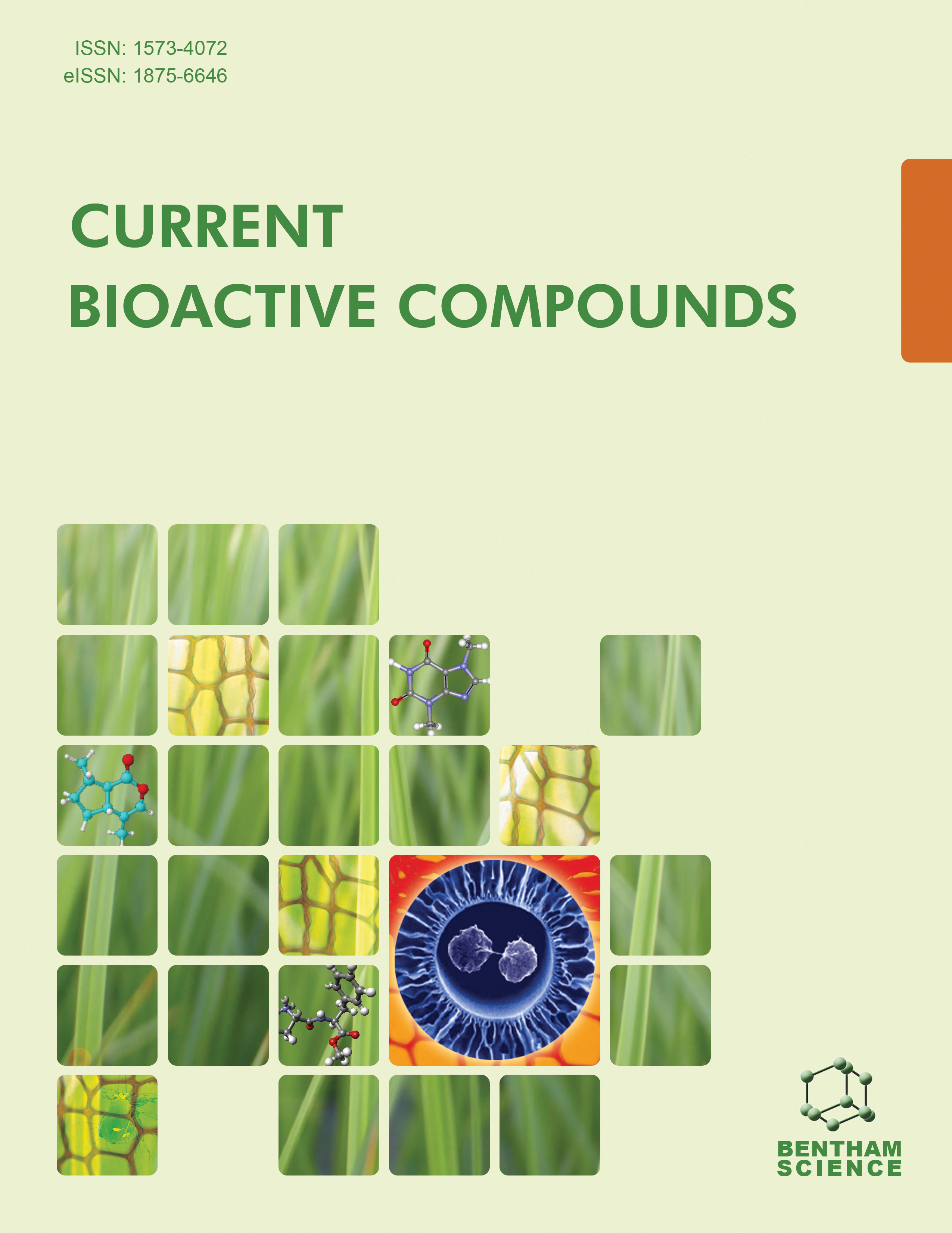- Home
- A-Z Publications
- Current Bioactive Compounds
- Previous Issues
- Volume 18, Issue 6, 2022
Current Bioactive Compounds - Volume 18, Issue 6, 2022
Volume 18, Issue 6, 2022
-
-
Chemopreventive Role of Phytoconstituents in Breast Cancer: An Integration Therapy
More LessAuthors: Priya Bhatt, Mehul Patel, Aashka Thakkar, Umang Shah, Ashish Patel, Nilay Solanki, Swayamprakash Patel and Sandip PatelAs we enter into the era of modern medicine, breast cancer remains a significant public health concern that has a noteworthy global impact in developed and developing countries. The modern era has seen an increase in the knowledge of the molecular mechanisms underlying cancer progression, leading to many anticancer drugs. The practice of curing certain diseases with the help of plant-derived compounds was on Read More
-
-
-
β-sitosterol in Various Pathological Conditions: An Update
More LessAuthors: Poonam Yadav, Chandan Chauhan, Sanjiv Singh, Sugato Banerjee and Krishna MurtiPhytosteroids are biologically active compounds found naturally in herb plasma membranes, with a chemical composition similar to animal plasma membrane cholesterol. It can be found in almost all fats abundant plant’s diets. One of the vital phytosterols is β-sitosterol which has several biological activities. It has been proved in various in-vivo and in-vitro research in which β-sitosterol stabilized several physiological activiti Read More
-
-
-
Pharmacological Importance of Peach Gum Polysaccharide: A Review
More LessAuthors: Ken Y. Goh and Lai Ti GewBackground: Peach gum is a natural gum exudate secreted from a peach tree (Prunus persica) by a process known as physiological gummosis. Peach gum is a natural biopolymer that is composed of acidic polysaccharides with a high percentage of arabinose and galactose subunit, which classifies it as an arabinogalactan. Objective: This review summarizes the composition, chemical structures, physical properties and biol Read More
-
-
-
Design, Synthesis and Pharmacological Evaluation of Novel Benzimidazole Derivatives as Anticancer Agents
More LessBy Remya R.S.Background: Cancer is undoubtedly a major challenge of modern era and is the second leading cause of death in the world. Lung cancer is the second most common cancer and the leading cause of cancer death among men and women. Non-Small Cell Lung Cancer (NSCLC) accounts for 84% of all lung cancer diagnosed. Benzimidazoles are important heterocyclic compounds possessing a variety of biological activities suc Read More
-
-
-
Antibacterial Activity of the Phenolic Extract of Wild Virgin Olive Oil In Vitro
More LessBackground: The olive tree (Olea europaea L.), the most widespread plant species in the Mediterranean basin, includes two forms: cultivated (var Europaea) and wild (var Sylvestris). Wild olive trees or oleasters cover large areas in Algeria. It has been shown that oil from oleaster has a higher content of phenolic compounds, which could have antimicrobial properties. Objective: The objective of this study was to assess the antib Read More
-
-
-
Cones of Coniferous Taxa as a Potential Source of Bioactive Polyphenols
More LessAuthors: Tamás Hofmann, Levente Albert, Balázs Bocz, Dániel Bocz and Eszter Visi-RajcziBackground: Coniferous cones are a by-product of forestry and wood logging, used for many possible purposes, e.g., the extraction of polyphenols. Objective: The aim of the present article was the comparison of the antioxidant polyphenol content of the differently matured cones of 17 selected conifers, either common in Hungary or yet uninvestigated. Methods: Total polyphenol content, ferric reducing antioxidant power and 2,2 Read More
-
-
-
Optimization of Microwave-assisted Extraction of Carotenoids from Citrus clementina Peels
More LessBackground: Citrus fruits, especially clementines, are among the most consumed fruits in the world. Clementine consists of pulp (endocarp) and peel (epicarp) which are rich in carotenoids. After using fruit pulp, peels are usually discarded as waste; the valorization of the latter in the recovery of its beneficial components, mainly carotenoids, may seem to be important. Objective: The main objective of this study is to determine Read More
-
-
-
Effects of Polymethoxylated Flavone Metabolites on ApoB100 Secretion and MTP Activity in Huh7.5 Cells
More LessAuthors: Danielle R. Gonçalves, Thais B. Cesar, John A. Manthey and Paulo I. CostaBackground: Citrus polymethoxylated flavones (PMFs) reduce the synthesis of liver lipoproteins in animal and in vitro cell assays, but few studies have evaluated the direct effects of their metabolites on this highly regulated process. Objective: The aim of the study was to investigate the effects of representative metabolites of PMF on the secretion of liver lipoproteins using the mammalian cell Huh7.5. Methods: In this study, the i Read More
-
Volumes & issues
-
Volume 21 (2025)
-
Volume 20 (2024)
-
Volume 19 (2023)
-
Volume 18 (2022)
-
Volume 17 (2021)
-
Volume 16 (2020)
-
Volume 15 (2019)
-
Volume 14 (2018)
-
Volume 13 (2017)
-
Volume 12 (2016)
-
Volume 11 (2015)
-
Volume 10 (2014)
-
Volume 9 (2013)
-
Volume 8 (2012)
-
Volume 7 (2011)
-
Volume 6 (2010)
-
Volume 5 (2009)
-
Volume 4 (2008)
-
Volume 3 (2007)
-
Volume 2 (2006)
-
Volume 1 (2005)
Most Read This Month
Article
content/journals/cbc
Journal
10
5
false
en

Most Cited Most Cited RSS feed
-
-
Podophyllotoxin: Current Perspectives
Authors: Ying Qian Liu, Liu Yang and Xuan Tian
-
- More Less

